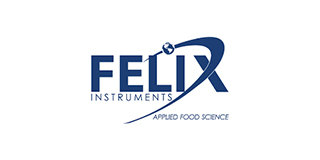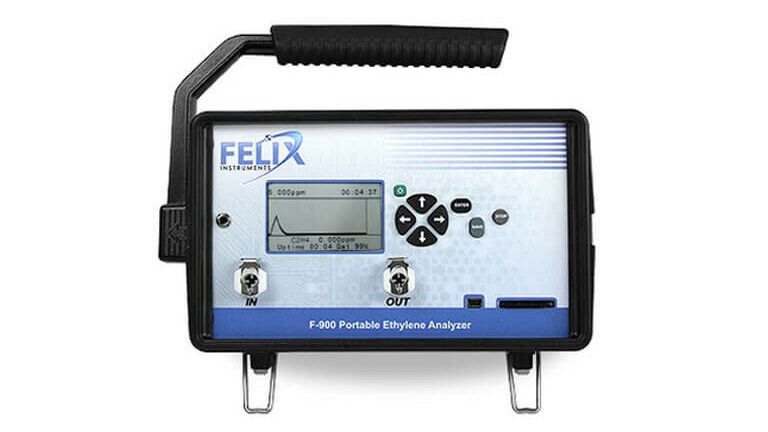

Felix Instruments
Measurements
How Does Controlled Atmosphere Storage Extend Fruit Shelf-Life?
Fixed gas analyzers, such as F-901 AccuRipe & AccuStore by Felix Instruments can monitor and control all the atmospheric features that need to be regulated in the postharvest stages

Each postharvest stage of fresh produce requires specific conditions to extend shelf-life and provide food that meets high-quality standards. Gas composition is one of the most crucial technologies in the supply chain, and gas analyzers and controllers are fast becoming standard equipment. In this article, you will learn the differences in atmospheres during ripening and storage and the reasons determining the choice.
Controlled Atmospheres
Postharvest, fresh produce is kept in controlled atmospheres where the temperature, relative humidity, and gas composition are altered from ambient conditions to control physiology. Postharvest physiology is linked to fresh produce shelf-life and losses. Hence, regulating various physiological processes of interest can improve quality and extend shelf-life.
The crucial physiological activities are respiration, transpiration, ripening, and senescence. Controlled atmosphere (CA) rooms/containers, ripening rooms, and modified atmosphere packaging (MAP) are developed to control specific physiological purposes.
- CA and MAP are used during storage and transport to prolong shelf-life and preserve fresh produce quality.
- Ripening rooms are programs designed to ripen, soften, and degreen different fruits.
The atmospheric conditions will differ in the two cases based on the physiological processes and the internal fruit atmosphere they aim to regulate. The gas composition controlled is oxygen (O2), carbon dioxide (CO2), and ethylene.
Gas Exchange Through the Fruit Surface
It is crucial to know the plant’s internal atmosphere and how it changes during ripening and storage to develop commercially altered external atmospheres.
At ambient temperatures, the internal fruit atmosphere is a mixture of CO2, O2, ethylene, water vapor, and volatiles like aromatic hydrocarbons, alcohols, sulfur compounds, etc., changing with maturation stages. See Figure 1.
The gases move between the harvested plant organ (root, bulbs, tubers, leaves, and fruits) and the environment. The direction and rate of movement is from a higher concentration to a lower concentration and will depend on gas properties and the intervening barriers. Gas is exchanged through the outermost organ layer (like cuticles and cracks), apertures (lenticels and stomata), and stem scar tissue. The fruit skin is a significant barrier; therefore, there is less gas exchange between internal and external atmospheres, and gas diffusion through the plant tissue is 10-20 times higher.
Plant morphology and anatomy, not biochemical processes, influence diffusion and levels of O2 and CO2 inside the fruits, though the internal and external atmospheres remain different.
The internal fruit atmosphere can vary depending on species, cultivar, and development stages, but a few common themes are present in the ripening and storage phases.

Figure 1: “Changes in various parameters during climacteric fruit ripening,” Paul and Pandey 2014. (Image credits: DOI: 10.1007/s13197-011-0583-x).
Ripening
Fruits have two types of ripening: climacteric and non-climacteric. The non-climacteric fruits are harvested ripe and require no postharvest artificial ripening. Only the citrus are treated with ethylene for degreening. The climacteric fruits are ripened at a desired time with artificially produced ethylene in ripening rooms using specific ripening programs customized for the species and cultivar. The ripening and degreening programs consider maturity stage, ethylene levels and exposure duration, temperature, and O2 and CO2 levels to be maintained.
Gas analyzers help in monitoring and controlling atmosphere composition to ensure the correct concentrations exist, which can include:
- Introducing higher ethylene levels: Ethylene regulates the development of fruit texture, color, flavor, aroma, and nutritional compounds during ripening. Moreover, ethylene shows an auto-inductive or positive feedback mechanism. When exogenous ethylene is applied, it triggers more endogenous (internal) ethylene production. Therefore, ethylene is introduced into ripening rooms periodically to maintain the required level, which can vary between 10 to 150 ppm, depending on the species. Food producers increasingly use ethylene since it is safer than chemical alternatives for ripening and getting the targetted sweetness, taste, and color.
- Maintaining high concentrations of oxygen: During ripening in climacteric fruits, there is a rise in respiration that happens simultaneously or after ethylene production. The climacteric surge in respiration can be triggered by external ethylene application. Ripening programs need a high oxygen level to allow aerobic respiration and prevent anaerobic respiration and decay. Higher oxygen concentrations are also required for ethylene biosynthesis and other ripening processes like softening, change in skin color through chlorophyll degradation, and decomposing polysaccharides to monosaccharides to increase sweetness.
- Lowering CO2 levels: Higher concentrations of CO2 inhibit ethylene effects and ripening processes, so their levels should be lower. However, due to increased respiration, more CO2 is produced, so the gas must be removed by ventilation to keep its levels below 0.5%.
- Maintain high temperatures and R.H: Warmer temperatures speed up ripening, but relative humidity is always maintained around 85-95% to prevent fruit transpiration and weight loss.
By measuring and controlling specific gases based on species-specific ripening, different aspects of the process and quality development can be regulated to produce uniformly ripe, tastier fruits that have a longer shelf life and meet customer acceptance.
Most of the atmospheric conditions are reversed during storage.
Storage
Storage aims to provide conditions so that fresh produce postharvest life is extended. In this stage, respiration, ripening, senescence, and transpiration rates that cause spoilage must be lowered as they negatively impact storability.
Lowering respiration reduces ripening and senescence and limits transpiration. The shelf-life of fresh produce is inversely correlated with respiration rate. As respiration rates decrease, the storage life increases.
Gas controllers help in providing the following standard storage conditions:
- Lower ethylene: While ethylene is introduced in ripening, its levels are reduced during storage to prevent softening of fruits and compositional changes. Ethylene is also responsible for senescence and tissue decay that follows ripening or due to stress and physical injury in climacteric and non-climacteric fruits and other harvested plant organs. So scrubbers are used to lower ethylene levels if it is above 0.005 µL/L. The ethylene sensitivity of the commodity determines its impact on ripening and senescence.
- Lower oxygen levels: Reducing O2 concentrations lowers respiration rate, ethylene production, and ripening processes. The reduction in respiration increases the storage life of the commodity. CA and MAP change the internal gas atmosphere of the fruits to lower the O2 to CO2 ratio.
- Increase carbon dioxide levels: Higher CO2 levels are maintained to prevent the ripening effects of ethylene, color development, lower respiration rate, and for its antimicrobial properties. CO2 technology is preferred over chemical alternatives to avoid pest and microbial infestations. CO2 cannot reduce the impact of ethylene produced due to stress.
- Lower the temperature: Low temperatures are the most popular means of extending storage life. It reduces respiration, transpiration, ripening, and senescence. The optimum range will depend on the type of fresh produce since chilling injuries also need to be prevented.
- High R.H.: Relative humidity is the only factor maintained at similar levels during ripening and storage. The R.H. must be around 85-95% to reduce transpiration, quality, and weight loss during storage.
- The O2 and CO2 ratio and ethylene concentrations for CA and MAP storage and transport are well established. CA is used for economically significant fruits like apples, pears, and kiwifruits. MAP is used for many whole and cut fruits and vegetables. Management that involves better monitoring and control of the atmosphere can safely extend shelf life and enhance fresh produce quality.
Gas Controllers for Ripening and Storage
Fixed gas analyzers, such as F-901 AccuRipe & AccuStore by Felix Instruments can monitor and control all the atmospheric features that need to be regulated in the postharvest stages- the three gases, temperature, and relative humidity. The sensors for ethylene and O2 are electrochemical, and NDIR (nondispersive infrared) technology is used for CO2 analysis. The AccuRipe and AccuStore have several sensors connected to a central unit through Modbus Integration for remote and safe monitoring. The unit can be used to report and maintain optimum levels of the gases during ripening, degreening, and CA storage to optimize fresh produce sales and revenue.


.jpg)













